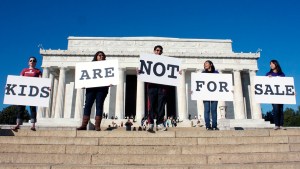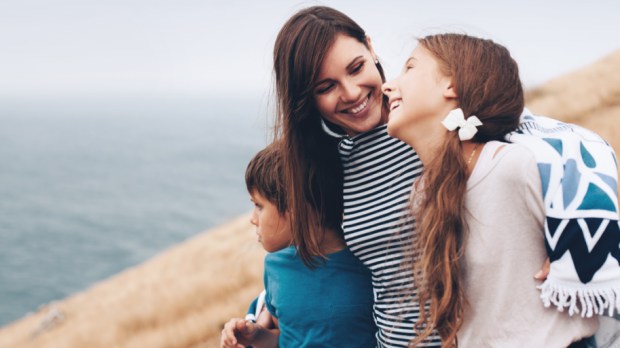You might have noticed there’s been a huge uptick of news about child sex trafficking in recent weeks. While it’s heartening to see this crucial issue receive needed attention and support, there’s a lot of misinformation swirling around too. So Aleteia turned to Lina Nealon, Director of Corporate and Strategic Initiatives for the National Center on Sexual Exploitation and a national leader in the fight against sex trafficking, to shed light on what’s fact and what’s fiction with regards to the trafficking industry—and a lot of it is different from what you might think.
Nealon explained what things parents should be the most concerned about, and what need not be a big worry. Parents can take action in the following 3 ways to keep their kids safe.
1Educate yourself about the reality of what trafficking looks like.
Misinformation about human trafficking is rampant, and unfortunately it detracts from the real work that needs to be done. “There are major misconceptions about what trafficking is,” Nealon said. “People see movies like Taken and think the risk is children being kidnapped off the street. But that is very, very rare.”
The stereotypical image of human trafficking is a person who is chained or locked up, and has been forcefully taken far away from home. But if you look at federal trafficking statistics, only 5% involve a locked room or chains or bars. And kidnapping is rarely involved.
“You don’t have to move anyone. That’s a common misconception,” she said. “It has nothing to do with movement. It’s about the state of being exploited.”
What usually happens, she said, is that sex traffickers will befriend children to create bonds. “Human traffickers prey on vulnerable children and adults, often those who are suffering from violence, abuse, or neglect at home, or have run away from home to escape those situations,” she said. “Traffickers also seek out those who are on the margins of society, and in the U.S. that means women and girls of color and LGBTQ youth are sexually exploited at disproportionate numbers.”
Parents can understand the reality of trafficking through reading reputable websites and organizations fighting against this evil. A great place to start is #TraffickingTruths: Realities of child sex trafficking!
Most of all, parents need to know that trafficking can happen anywhere, even in seemingly safe, wholesome communities. But the greatest danger to your child isn’t strangers on the street. It’s the internet.

Read more:
These 8 organizations are leading the critical fight against sex trafficking
2Closely monitor your child's internet use.
The greatest threat to most children is not being snatched from their parents in the supermarket parking lot, as social media would have us believe. It’s in their own homes and bedrooms, on their phones and tablets. “Social media apps are becoming online marketplaces for trafficking,” Nealon said.
She referred to a focus group her organization did this year with youth ages 16-18 from stable families in the wealthy suburbs of Washington, D.C. “100% of them had been solicited for sex online by a stranger,” she said. “The numbers are just staggering.”
Predators use these apps to reach children in various ways, Nealon said. Many traffickers pretend to be children to get real children to let down their guard and trust them. They also direct message children to build a bond and relationship, send them pornographic material, or entice children to send explicit photographs of themselves.
“Parents need to be very vigilant, informed, and aware about their children’s online lives,” she said. She recommended Protect Young Eyes, an extremely helpful website that offers thorough reviews of all the popular apps, from a perspective of safety. The site also offers free webinars for parents to learn to manage their children’s tech use.
The same approach of vigilance and caution extends to video games. Many include sexually explicit material or allow unknown users to message your child. Again, Protect Young Eyes has full information on the pros, cons, and risks of popular video games and gaming systems.

Read more:
Human trafficking getting worse during pandemic, Catholic groups say
3Equip your children to protect themselves by educating them from a young age.
When it comes down to it, there is only so much you can do to keep your child away from internet predators. Eventually, most kids will get on social media, even if it’s not until they leave home. That’s why the single most important step to keeping your kids safe is to educate your child about sexting, pornography, sexual predators, and other dangers online. By educating them about the reality of what is out there, you equip your children to make wise decisions and protect themselves.
It can be hard to initiate these conversations! Perhaps you don’t want to introduce such upsetting topics if your child hasn’t heard of them before, or you aren’t sure how to approach the subject. Maybe you think there’s no need to discuss it at all. But as the Protect Young Minds website explains,
It’s agonizing for most parents to even think of talking to young children about pornography and internet safety. Your parents didn’t recognize the need to talk with you about pornography, so it’s hard to know how or when to start! Your children are growing up in a different world than you did –- a world where a predatory porn industry is seeking to hook your vulnerable children as early as possible. Parenting has never been easy, but mobile devices with high speed internet access to hard core material has made it even more challenging.
The truth is that predators are constantly finding sly new ways to contact young people online. Go on the offensive and give your children the tools they need to keep themselves safe from bad actors online.
Nealon recommended the books Good Pictures, Bad Pictures and Good Pictures, Bad Pictures Jr. for kids as young as 3, depending on how much access they have to the internet. “The average age of first exposure to hardcore pornography is 11,” she said. “It could pop up on apps, on social media, even at school. A child could stumble across it by accident. Unfortunately, it’s extremely easy to find.”
Protect Young Eyes has great resources for determining when your child is ready for social media. And Protect Young Minds offers Brain Defense, “an engaging, video-based curriculum to keep kids safe from cyber-bullying, pornography and internet addiction,” along with many other helpful resources. The curriculum even offers a Catholic supplement, drawing from Theology of the Body, Scripture, and the Catechism to reinforce its lessons.
“If kids are using apps, they need to know what predatory behavior looks like,” Nealon said. Parents might not realize the risks of internet use, but the truth is that educating your kids about all aspects of internet safety is the most important strategy for keeping them safe. Nealon said, “It might not seem like it’s that connected to trafficking, but it really is, given what we have seen about how traffickers reach young people online.”
One especially insidious newer trend is “sugar dating,” in which an older man offers to pay off student debt for a young women in college, in exchange for sexual favors. “Every parent with a college-aged daughter needs to warn her about this,” Nealon said. “This is trafficking.” The young women are sold a bill of lies about “autonomy” and “experience,” but the reality is “a much darker story of deception, violence, and exploitation,” reads the End Sexual Exploitation website. “Make no mistake, sugar dating is pseudo-dating prostitution and it is vital to push back against the normalization of such an exploitative trend.”
Traffickers and predators have many deceptive and evil strategies, but parents, grandparents, teachers, and all people of goodwill can fight back. Educate yourself about the reality of trafficking, communicate about and closely monitor your child’s internet usage, and most of all, give your children the education and tools they need to protect themselves. These strategies will go a long, long way to keeping the young people you love safe.

Read more:
Saints throughout history who fought human trafficking

